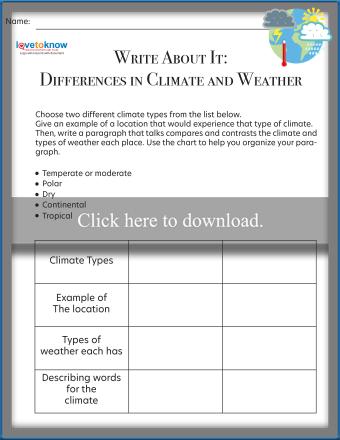
Learning the difference between weather and climate can be tricky at first. One of the key differences has to do with time. Weather involves air conditions that occur over a short time, while climate involves the average patterns of weather over a long period of time.
Definition of Weather
What is weather? Weather is the condition or state of the atmosphere (air) at a specific place or time. Weather can change quickly and may change throughout the day. Factors that you can use to describe what the weather is like include the type of precipitation, the temperature, the wind conditions, and air pressure. Any time one of those factors changes, the weather changes.
Examples of Weather
There are many different types of weather and different weather conditions. When you say it is rainy, that is the type of precipitation. Snow, sleet, and hail are also examples of precipitation. The weather may be hot, cold, warm, or cool. You can use these terms as well as state the specific temperature. For example, "It is 75 degrees today." The weather may be windy or calm (little or no wind). Air pressure can be high or low. Low pressure may have clouds and precipitation. High pressure usually means calmer weather. It may also be warmer and have little or no precipitation.
Definition of Climate
What is climate? Climate is the pattern of weather in a certain place over a long period of time (usually 30 years or more). Scientists determine an area's climate by observing its weather patterns over many years. While climate can change, it changes very slowly. While there are some similarities between weather and climate, climate is different from weather because weather can change very quickly and describes the air conditions at a certain time and place, not the patterns that emerge over long periods of time.
Types of Climates
There are several major types of climates. These describe the average weather patterns of an area. They include:
- Temperate or moderate - This type of climate may have cool or cold winters and warm or summers. Temperatures change throughout the year and with the seasons. Temperatures are not extreme. Summers can be humid and rainy.
- Polar - Areas with these climates have extremely cold winters. They stay cold or cool most of the year. Even summers are not very warm in Polar climates and summers can be short. These regions may be located on a tundra.
- Dry/Arid - Dry climates have very little rainfall. They may be located in or near deserts. Temperatures can be very hot in the daytime and much colder at night. Some areas with this climate have cold winters and hot summers.
- Continental - Regions with this type of climate usually experience warm to cool summers. Winters are typically have very cold temperatures, and winter weather may include lots of wind and snowstorms.
- Tropical - In this type of climate, the weather is usually very hot and humid for most of the year. They have a lot of rainfall throughout the year. Some areas (like rainforest regions) might be warm and wet all year round, while others might have periods that are warm and wet and periods that are warm and dry.
Weather Vs. Climate Worksheets
Once you've discussed the differences between weather and climate, you can use these worksheets to help reinforce concepts and evaluate students' knowledge of the topics. To get the following worksheets, simply click on the image and it will appear in a new window as a printable document. If you need help downloading or troubleshooting the printable, see this helpful guide on Adobe printables. There are three printables, so you can use them for different reading levels, grades, or activities.
Climate Vs. Weather Sort
Most elementary kids love sorts - which often seem more like games than a worksheet or learning activity! To have fun with science in learning about weather and climate, print out both the sort chart page and the sort cards for your student(s). The last page is an answer guide. This is good for introducing the ideas or for less advanced readers.

- Individual activity - At individual desks or learning stations, students can do the sort on their own. Have them cut and paste the climate and weather examples into the appropriate spot on the chart.
- Centers - This could also be done as a center activity for a science center. Children could work individually or together in small groups at the center.
- As a class - Put the chart itself on a smartboard (or white board), then print and hand out sort items to students in a group (at a carpet or in a circle together in the classroom). Call on students to read aloud his or her card, and then have the, tell you where it should go. Mark that item in the chart for the class to see.
- Timed sort - Make it fun by printing the chart and sort cards, then give students a set time to see how many they can put on the correct side.
Differences in Climate and Weather Worksheet
This worksheet is good for mid-level readers or could also be used as a pre-test or study guide. The worksheet includes a multiple choice section, a matching section (match items to either climate or weather), and a short answer section that requires students to name the type of climate that the each description provides. An answer guide is included on the last page of the printable.

Climate and Weather Writing Worksheet
For older or more advanced readers and writers, or if you are looking to incorporate a cross-curriculum literacy and science activity, this worksheet is ideal. Make sure you have discussed examples of climates and weather and explained them well beforehand. Students will use the included chart to jot down their ideas, and then write a paragraph about two different types of climates, with examples of the weather and location for each. Students will also be challenged to use their vocabulary to give good adjectives that illustrate each type of climate. This could be used in class or assigned as a take-home project. Alternatively, teachers could use this as a class activity and discuss it using the chart.

More Activity Ideas on Climate and Weather
Some simple activities can help strengthen student's knowledge and make learning about the difference between climate and weather fun.
Map It
Point out different places on a globe or world map. Ask students what type of weather and climate an area has, and discuss the correct answers as a class.
Weather Writing
Ask students to make observations about the weather in the local area. You could also use this as a writing or journal activity by having them write about the types of weather your are has. Make it personal to them by asking them to describe their favorite type of weather and why.
What About Seasons?
Some students may be confused about the difference between seasons and time. Model the idea that weather is short term, seasons take place during part of the year, and climate takes place over long periods of time. A simple way that students could do this is cute different sized pieces of paper and label each one Weather, Climate, and Season to reinforce the concept.
Around the World
Give students an example of a climate in a different part of the world. Discuss as a class or have students write and describe the climate and how it would impact the lives of people who lived in it.
Musical Circle Toss
With students sitting in a circle, hand one student a small object like a ball or small stuffed animal. Play some music in the background and stop it at random intervals. When the music stops, the student holding the item must name either a type of weather or climate, then they toss the item to a classmate. The classmate will then need to identify whether it is a type of weather or a type of climate
Best Shelters
Discuss what types of shelters might be needed in different climates - this can be a combined art and science activity. Give students some example climates, and then have them draw and describe what type of shelter would be best for them. If you want to infuse more creativity into this activity, ask students to come up with new and innovative features of shelters that would make them great for the type of climate beging discussed. You could also do a hands-on activity such as shown in the video below to creates shelters that could withstand severe weather in different types of climates.
Make Learning Fun
Choosing the right activities and worksheets to reinforce the differences between climate and weather for kids can help make learning about this topic fun. Add your own twists to these ideas and adjust them as needed to make them work for your students. For more advanced learning, you may want to consider moving on to objectively introduce the idea of climate change to kids.







